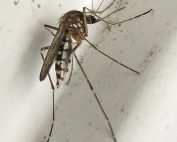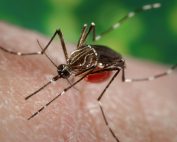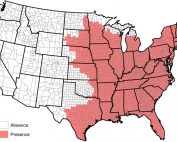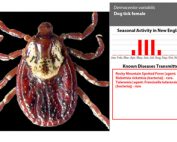10 Ways to Protect Yourself from Mosquitoes
Top Ten Things To Limit Mosquito Bites: Wear pants and shoes - Aedes Albopictus bites ankles - no flippy floppies Wear florescent and loose clothing - Asian Tiger is attracted to dark colors and can bite through clothing that does not have a close knit. Monitor your property closely for artificial and natural containers that will collect and hold rain water Keep grass and bushes trimmed, leaves racked to create maximum sunlight on your property. Avoid tunnels and other damp areas that do not get sunlight. Aedes mosquitoes prefer shade and will generally only fly into sunlit areas to feed. This means that if your property has a lot of shaded areas it will harbor Asian Tiger mosquitoes. Shade also slows the evaporation of water from containers so creates breeding sites for these Mosquitoes. Check your rain gutters cleaned every year so that they are not clogged which will result in water stagnation and larval development. Avoid going out and dawn and dusk. Both daytime and nighttime feeding mosquitoes will bite at these times Check window and door screens to ensure they are in good condition and seal tightly Encourage friends, family, and neighbors to follow these recommendations also. Sign [...]
What Attracts Mosquitoes?
People often ask us what attracts mosquitoes? And why do I get bitten up while they ignore my wife? Here are a few mosquito attractants: Mosquitoes do seem to favor people with certain blood types. One experiment showed that people with O blood types were two times more likely to be bitten than those with type B and that type B was twice as likely to be bitten as Type A. This is true for the 85% of people who have a chemical secretion that reveals their blood type to mosquitoes. Mosquitoes are attracted to CO2. Therefore, they are attracted to larger people and pregnant women who emit more CO2 than other people. Mosquitoes may also go after people who have been drinking a lot of beer because of their increased CO2 emission and warmer body temperature. Lactic acid - comes out when you sweat but they have found that mosquitoes really like it when sweat dries. So if you are going for a run, run fast! And if you relax outside after your workout and allow to sweat to dry - you will become a mosquito magnet.
Disease Transmission Vocabulary
Clients sometimes ask about the potential spread of a mosquito-borne illness in our area. To address these questions we decided to put together a list of the definition of important words that help explain the nitty gritty of disease transmission. Mosquitoes are VECTORS. This is when an organism can transmit a disease or parasite from one animal or plant to another. Vector competence is the ability of mosquitoes to acquire, maintain, and transmit microbial agents. When a mosquito penetrates the skin, it draws a blood meal which can contain the virus. Although there may be a lot of the virus inside the mosquito, the mosquito itself is not ‘infected’, it is a carrier. If a mosquito bites you, even for just one or two seconds, that is long enough for it to secrete saliva, and that has instantaneously transmitted the virus to you, even if the mosquito does not get its blood meal. The mosquito needs a blood meal for it to become infected, a carrier if you will, but can infect another person without getting a blood meal. Vectoral Capacity is the clue of how important a particular species would be in the real world for disease transmission based [...]
Tick Treatment and Protection
https://www.youtube.com/watch?v=_IoOJu2_FKE&feature=emb_logo Ticks go through four life cycles: egg, six-legged larva, eight-legged nymph, and adult. After hatching, a tick must eat a blood meal at each stage to advance to the next. It is typically during the larval stage that a tick becomes infected with a disease. It will then be able to spread this disease to other animals and humans throughout its life. Once a tick has taken enough blood and is fully engorged, it drops from its host. Unlike the speedy mosquito who bites and runs, if undisturbed, a larval tick will feed for three or four days and an adult tick seven to ten days. Once satiated, it falls off, molts, and develops into its next life stage. This process repeats until the tick reaches adulthood and feeds upon a third and final host. After the adult female has fed and mated, it will find an area to lay thousands of eggs and die. This entire cycle can take up to three years, depending on the type of tick. Tick Physical Structure The tick mouth consists of two palps, two chelicerae, and one hypostome. When a tick bites a host, the two palps move out of the [...]




